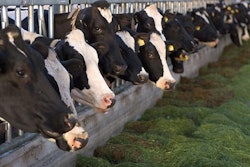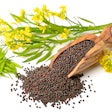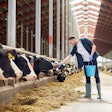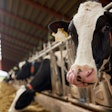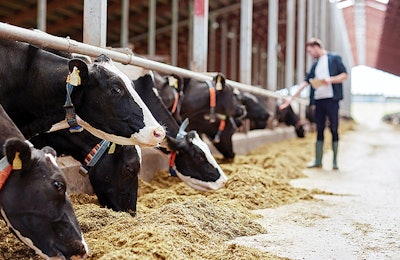
Feed costs represent the highest expense to dairy producers. As a consequence, maximizing utilization of nutrients is essential to the profitability and sustainability of dairy farms.
Feed efficiency is usually defined in dairy cows as the ratio of milk output to feed input, namely, milk yield to feed intake. Since feed efficiency is a ratio of two metrics, cows with higher milk production and lower intake are more efficient. In addition to milk production and dry matter intake, other parameters that have been associated with efficiency are genetics, breed, age, lactation number, pregnancy state, body weight (BW), BW change and body size.
Feeding of fiber-degrading enzymes has been proposed as one way to increase efficiency due to higher nutrient bioavailability in feeds. Data obtained from studies on dairy cows, however, is not promising. In these studies, milk output was defined as yield in kilograms, fat corrected milk or energy corrected milk, while feed input was expressed as kilograms of dry matter intake (DMI).
Improved feed conversion
Only two out of 17 experiments reported increments in feed efficiency when fiber-degrading enzymes were fed to dairy cows. Improvements in feed conversion efficiency in both experiments were due to lower DMI without changes in milk production.
Diet composition and enzyme dose influenced feed conversion efficiency in these studies:
- University of Florida researchers reported a significant increase in milk production efficiency — fat corrected milk (FCM)/DMI; 1.46 vs. 1.62 — in cows fed a low concentrate diet (33 percent concentrate DM basis) treated with a fiber-degrading enzyme. The authors, however, did not find an effect in those fed a high concentrate diet (48 percent).
- Canadian researchers found milk production efficiency increased linearly with increasing enzyme addition. Cows in early lactation fed an enzyme added to the diet at a high concentration (0.5 mL/pound of DM) increased production efficiency by 11.3 percent. At a lower enzyme concentration (0.25 mL/pound of DM), production efficiency did not differ from that in the untreated diets.
Reduced feed efficiency
On the other hand, three studies (17.6 percent) reported reductions in feed efficiencies when fiber-degrading enzymes were supplemented.
In their first trial, University of Idaho researchers observed decreased feed efficiency in both early- and mid-lactation cows receiving forage sprayed with a solution containing cellulases and xylanases.
Read the first and second installments of this three-part series on exogenous enzymes: Benefits of fiber-degrading enzymes in dairy cow diets and Fiber-degrading enzymes increase dairy cow milk production.
In their second trial, the authors reported similar production efficiency in early lactation cows consuming forage treated with a medium-enzyme dose and cows fed untreated forage. Milk production efficiency was lower in cows fed forage treated at low- and high-enzyme dosages and did not differ even though both low- and high- dosage groups ate more than control cows.
The authors suggested that greater DMI might have been deposited as body fat rather than milk production.
Another experiment conducted in early lactation cows also reported lower feed efficiencies when cows were fed a commercial fiber-degrading enzyme at higher rates (2.3 gram/pound) with no effects observed at a lower dose (1.2 gram/pound). These results indicate the importance of determining optimal enzyme concentrations to be included into diets.
Effects on body reserves
Dairy cows mobilize body tissues to support energy requirements for milk production during early lactation and replenishing tissue reserves for the subsequent lactation during mid- and late-lactation. Fiber-degrading enzyme supplementation had negligible impact on body reserves of lactating dairy cows.
Only one study out of 17 reported higher BW gains when a commercial enzyme formulation was fed to lactating dairy cows. In this study, Virginia Tech researchers reported that cows fed diets containing enzymes gained more weight than those on the untreated diet (+1.32 vs.−0.07 pounds/day). Moreover, the change in weight gain was greater in early lactation (+2.6 pounds/day) than in late lactation cows (+0.22 pounds/day).
In contrast, Kansas State University researchers reported lower BW gains when cows were fed fiber-degrading enzymes at a high dose compared with control cows. Moreover, weight gain was less for cows receiving intermediate amounts of fiber-degrading enzymes (5 and 10 grams/day) than those fed either no enzyme or at the highest amount (15 grams/day). It is surprising that in some experiments increased total tract dry matter and neutral detergent fiber digestibility of the diets due to enzyme supplementation did not affect change in BW, given that milk or milk components (fat and protein) yield were also not affected.
Implications for production
Attempts to improve dairy cow performance with fibrolytic enzymes applied to the feed at or only hours before feeding have yielded variable production responses.
No effects of fiber-degrading enzymes were found on intake, milk production, feed efficiency or body reserves of dairy cows in 10 out of 27 experiments evaluated in this review. This inconsistency may be due to variable forage-to-concentrate ratios, application rates, lactation stage, the fraction of the diet to which enzymes were applied and enzyme combinations.
Currently, the use of fiber-degrading enzymes in commercial dairy farms seems not to be cost effective given the relatively high price of enzyme additives, their inconsistent response, and the potential of improving cow performance with other additives. More research is required using long-term studies to provide more consistent and reliable results of the economic impact of feeding fiber-degrading enzymes to dairy cows.
Editor's note: This is the third and final installment in a three-part series on exogenous enzymes.


